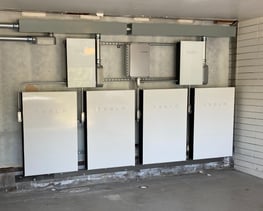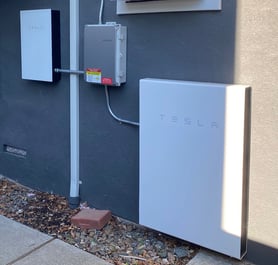Solar energy storage systems like the Tesla Powerwall are changing the energy equation for California homeowners, much like the introduction of affordable, high-performing solar panels did ten years ago. These systems, which are also called battery backup systems, are paired with solar energy systems to give homeowners even more value from their solar panels.
Tesla’s Powerwall system is one of the oldest and one of the most popular battery products available today. Our solar professionals field storage questions from homeowners on a regular basis, so we thought it might be helpful to provide this post explaining everything you need to know about the Tesla Powerwall.
What does a Tesla Powerwall do?
The Tesla Powerwall stores some of your extra solar electricity so it can be used when you choose, to reduce your energy costs and provide peace of mind. The Powerwall is typically used in these three situations:
- Your solar system is not producing enough for your use, such as at night or on cloudy days, so you draw from the battery
- Utility “time of use” rates are highest and you prefer to use the low-cost, solar-generated electricity stored in your battery
- A power outage cuts the utility electricity feeding your home; you draw from your battery to power some of your home’s needs.
In short, the Powerwall allows you to get even more value from your solar energy system.
(You can install a Powerwall without solar but the utilities charge high interconnection fees in that situation. For example, PG&E’s fee as of this writing is $800. If your project fails the utility’s initial review, they charge an additional $2,500 supplemental review fee.)
How does a Tesla Powerwall work?
Like most solar energy storage systems, the Powerwall system is a compact unit typically installed outside the home or in the garage. The Powerwall 2, as it’s known, measures 45.3 inches high by 29.6 inches wide by a mere 5.75 inches deep.
The heart of the system—the rechargeable batteries—are lithium-ion, the same type used in everything from cell phones to laptop computers to power tools. Tesla produces its own lithium-ion cells, similar to the lithium nickel manganese cobalt oxide (NMC) battery cells the company uses in its electric vehicles. This common technology is proven, safe, compact, and affordable.
In addition to the battery, the system includes a Tesla Gateway, which is a “transfer switch” that disconnects your solar and batteries from the utility grid during an outage. The Gateway matches the batteries with a white glass door; it measures 26 inches by 16 inches by 6 inches.
Any solar energy produced by your solar panels but not used right away flows into the Powerwall’s battery where it is stored until you choose to draw upon it. When the battery is fully charged, your excess solar energy flows into the utility’s grid for use by others.
Your solar panels do not need to be made by Tesla to work with the Powerwall, and Citadel can add a Powerwall to an existing solar energy system.
How much does a Tesla Powerwall cost?
Be aware that many of the prices you’ll see quoted online can be misleading as they are only for the units themselves. But you’ll also need to pay for installation and related hardware and materials.
The price for a system varies widely based on how much of your home you want to power and for how long, how many batteries your system includes and, to a lesser extent, whether or not you install the battery system with solar. (Doing both projects together introduces some economies of scale.)
Two generous government programs offset battery system prices, which start in the tens of thousands of dollars.
First, a battery system qualifies for the federal Investment Tax Credit (ITC), provided it is charged by a renewable energy system such as solar. The ITC pays you back 26 percent of the cost of the energy storage system, reducing the price by thousands of dollars. For example:
| Starting Price | 26% ITC | Final Price |
| $20,000 | $5,200 | $14,800 |
| $30,000 | $7,800 | $22,200 |
Then, the Self-Generation Incentive Program (SGIP) in California provides rebates for residential and commercial solar energy storage systems. The rebates are funded through a surcharge on California electric bills. Since you’re helping fund the program through your monthly payments to the utility, wouldn’t it be nice to benefit from it too?
How many kWh does a Tesla Powerwall hold?
Tesla has continually improved the Powerwall since its introduction in 2015. The Powerwall 2 can store 13.5 kilowatt-hours (kWh) of electricity.
To fully charge the battery, you’ll probably need a 4 to 6 kilowatt (4,000 to 6,000 watt) solar energy system – that’s about 10 to 14, 400-watt panels. Each installation is unique, with factors including panel efficiency and size, number of panels, roof direction, shading, and household electricity demand and use all figuring into the equation for how much solar and how many batteries your home will need.
The battery’s kWh rating refers to the maximum amount of electricity the battery can store – the higher the number, the longer the battery can run your appliances before needing to be re-charged.
A related figure is the battery’s power capacity, which refers to the maximum amount of electricity the system can put out at once – the higher the number, the more appliances it can power simultaneously. The Powerwall’s maximum continuous power output is 5 kW per battery.
On both counts, the Powerwall rates are at the high end for systems available today.
How long can Tesla Powerwall power a house?
The average American home consumes about 11,000 kWh of electricity per year, or 30 kWh of electricity per day. The average California home uses considerably less, thanks to our temperate climate which reduces heating and cooling needs. Our average is around 7,000 kWh per year, or roughly 19 kWh per day. Larger homes obviously use more than the average; smaller homes may use less than the average.
(Sadly, the amount of money Californians spend on electricity is much closer to the national average due to our high electricity costs – another reason to make your own, low-cost solar energy!)
As we said, a Tesla Powerwall can store up to 13.5 kWh at a time. So theoretically, if your home uses 19 kWh a day, you might think the battery would power all of your home for a good portion of the day during a utility outage.
But today’s Powerwall does have limitations. One standalone battery cannot typically support an electrical load on a 30-amp breaker. So one battery might not be able to power a well pump, EV charger or air-conditioning unit.
To extend the time for which they can rely on batteries during an outage, most people choose to only power a few key appliances and devices, such as the refrigerator, WiFi and some lights.
For greater and/or longer battery backup coverage, many homeowners install multiple Powerwall units. You can install up to ten. Systems with one to three units are the most common, and two can power most single-family homes.
How long does a Tesla Powerwall last?
The battery systems are engineered and designed to be installed indoors or outdoors and are warrantied for 10 years. Like most batteries including those in your cell phone, the Powerwall’s ability to hold a charge lessens slowly over time, and it’s best not to expose the batteries to extreme temperatures. Tesla guarantees its Powerwall will maintain at least 70 percent of its capacity for a decade.
Ready to learn more?
Citadel has installed Tesla Powerwall and other brands of energy storage systems throughout California. Our installation package includes system design and engineering, procurement of all equipment and materials from leading manufacturers, installation following industry-leading standards, HOA and local permits, and utility approvals.
Once your energy storage system is up and running, we’re here to answer questions and provide any maintenance or repairs down the road.
Contact us today at (800) 400-2852 if you’d like to learn what solar energy storage can do for you, your home and your family. We can assess your home’s energy demand and usage and calculate what kind of backup and/or cost savings you could expect from a battery system.
Learn more on our Learn page and our Solar Energy Storage page, including ways to pay for energy storage and more on incentives that offset the cost. Businesses interested in energy storage can learn more here.


